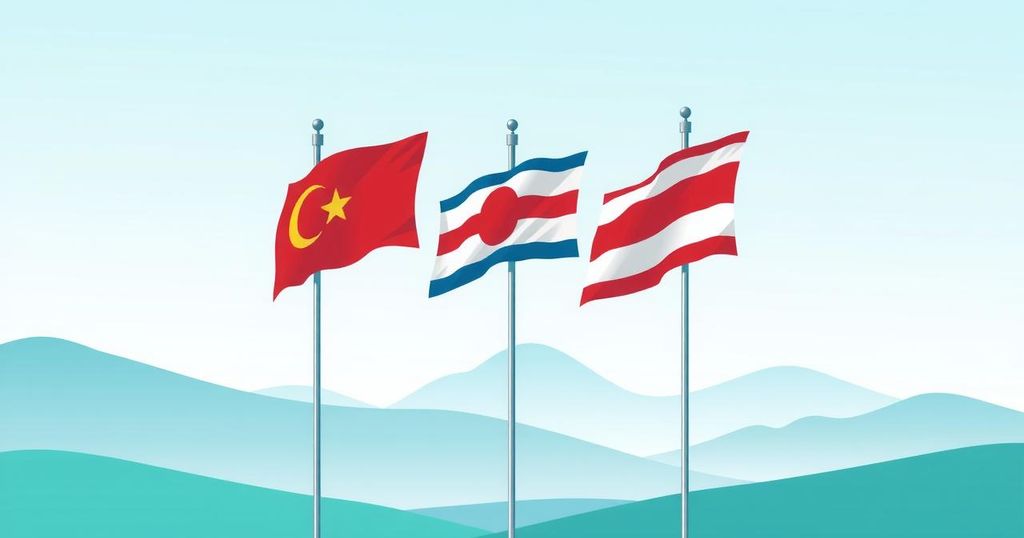The Trump administration is seeking peace between Russia and Ukraine, but Kazakhstan faces challenges from the ensuing conflict affecting its oil exports via the CPC pipeline. Recent drone attacks have raised questions regarding compliance with ceasefire agreements, while Kazakhstan’s surging oil production may complicate adherence to OPEC+ quotas. Despite these issues, analysts suggest a stable market outlook for upcoming quarters, with demand anticipated to outpace supply.
In recent weeks, the Trump administration has made efforts to negotiate a peace deal between Russia and Ukraine, stirring hope for an end to the three-year conflict. However, Kazakhstan, an OPEC member, faces challenges as it finds itself caught amidst the geopolitical tension, particularly regarding the Caspian Pipeline Consortium (CPC). Last week, a drone attack damaged the Kavkazskaya oil depot in Russia’s Krasnodar region—part of the CPC—prompting accusations between Russia and Ukraine. Last year’s oil output via CPC was approximately 130,000 tons monthly, supplying about 1% of global oil. Major shareholders of the CPC include Chevron Corp., Shell Plc., and Eni S.p.A.
According to Kazakh journalist Oleg Chervinsky, the CPC was included in Trump’s ceasefire moratorium on strikes between the two nations, indicating a breach of these terms due to the recent attack. There remains confusion regarding adherence to the ceasefire, as both parties accuse each other of non-compliance. A limited ceasefire was agreed upon, yet with conditions that suggest a virtual demand for Ukrainian surrender by Russian President Putin.
Vladimir Chizhov, Deputy Chairman of Russia’s Defense Committee, noted, “They sat for 12 hours and seemed to have agreed on a joint statement,” indicating the complexities in achieving consensus with Ukraine. Nonetheless, the burden of blame appears to have shifted toward Russia, with Trump reportedly expressing anger towards Putin for undermining Zelensky’s credibility. Trump has also threatened significant tariffs on Russian oil, signaling a shift in his tone.
The ongoing assaults on Kazakhstan’s energy sector jeopardize its economy. Oil and gas analyst Olzhas Baidildinov reported that CPC delivered $1.3 billion in dividends last year, benefiting Kazakhstan’s state budget by about $85 million. These attacks are particularly detrimental as Kazakhstan increases oil production to alleviate its budget deficit. Recently, the nation’s output reached a record high of 2.12 million barrels daily, reflecting a significant 13% rise since January.
Contributing to this growth is the Tengiz oilfield, where Chevron Corp. is actively expanding operations. Moreover, Kazakhstan is considering significantly increasing oil exports through Turkey’s port of Ceyhan. Energy Minister Almasadam Satkaliyev mentioned the potential rise in exports via the BTC pipeline to 20 million metric tons annually from the current 1.5 million.
Nevertheless, uncertainties linger regarding compliance with OPEC+ production quotas, as Kazakhstan’s output exceeds its quota of 1.468 million barrels daily. To address overproduction, Kazakhstan is expected to compensate with a cumulative reduction of 620 kb/d by September 2025. Fortunately, analysts from Standard Chartered have indicated that fears of a supply surplus are unsubstantiated thus far, predicting demand will outstrip supply in the upcoming quarters without surpluses appearing in the near term.
The geopolitical tensions surrounding the Ukraine-Russia conflict have significant implications for Kazakhstan, particularly regarding its oil production and exports. Efforts to broker peace may affect the CPC pipeline, the main export route for Kazakh oil. Despite potential challenges in adhering to OPEC+ quotas and the need to compensate for overproduction, the outlook for Kazakhstan’s oil market remains cautiously optimistic with projected demand exceeding supply in the forthcoming months.
Original Source: oilprice.com




